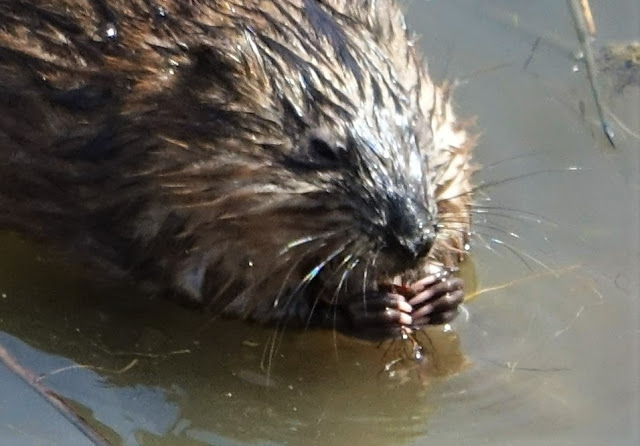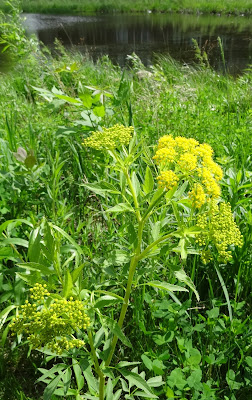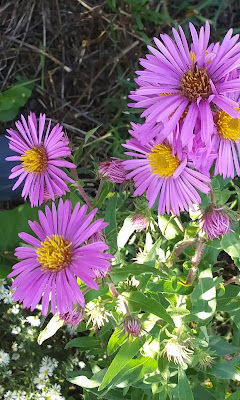4/20/2023
hooded mergansers in Spring
We have three types of Mergansers in North America. The smallest of the group is the Hooded Merganser. These are diving ducks; their long bills are slender with serrated edges, formed like teeth for grasping and holding their prey. They dive in lakes or ponds, staying under water up to two minutes, while hunting for small fish, crustaceans, amphibians, or roots.
4/16/2023
blue-wing teal in Spring
4/12/2023
muskrat claws
The muskrats Ondatra zibethicus who live on the pond are semi-aquatic rodents.
They eat mostly plant matter, but also smaller critters that they find. To eat, they have a thumb and four fingers -- with claws -- to grasp food. The back feet are larger and have five webbed fingers that help swimming in ponds, lakes, and rivers. They swim under water hunting for vegetation that they gnaw and chew with large incisor teeth located in front of their cheek. Or, they may sit on shore chewing terrestrial grasses.
4/10/2023
tree swallows find nest box
We have boxes that Tree Swallows use to nest in. This bird was checking the box for suitability.
The box has a 'Sparrow Spooker' (nylon line attached securely with hook-eyes on top and around the entrance) that protects eggs and babies of Tree Swallows from House Sparrows who cannot negotiate the lines. House Sparrows destroy eggs and baby birds in other species' nests.
4/09/2023
first turtle of Spring
Adult painted turtles Chrysemys picta begin active foraging usually in March or early April. Since winter has held on strongly until now, we only saw the first turtle today when the sun was shining and temperature is in the 60's F.
Shortly after awaking from winter, courtship begins. If they laid clutches of eggs last fall, the little hatched turtles probably over-wintered in the nest. Now they emerge and instinctively seek the security of water in the pond.
Today, the Spring Peepers are singing too!
4/05/2023
mallards arriving
Even though Spring is here and the birds have been moving to their nesting areas in Minnesota, the ice is thick on the middle of ponds. The Mallard pair is finding food in the open water near the shore. They act like ice-breakers with their beaks and legs to get to the plant material beneath the water.
4/02/2023
blizzard and frost depth
Because so much insulating snow came down early in November and piled up repeatedly throughout winter . . . soil frost depth is minimal at this time. With all the moisture in the ground, it should be a good year for wildflowers!
3/12/2023
Spring is coming . . .
On the bright side, plenty of moisture in the soil portends a great blooming season for wildflowers.
Look forward to seeing these early bloomers in a few weeks, once the snow melts.
Golden Alexanders, right, blooms in April.
Blue Flag Iris, below, blooms in May.
2/09/2023
tracks surrounding
Last winter, the critters chewed on the tree bark. A little wire fence protected the Tamarack tree this season.
I see proof of success by the tracks surrounding the fence!
Sorry for so many photos of WHITE . . . we have gotten a lot of snow!
2/02/2023
log in deep snow
The pond is covered by more snow than we have seen at one time in the last decade. This area has an average of about 50 inches of snow each winter season. By the end of January, we had more than that. The log and the big rock are barely visible, but we can see many tracks of the critters who walk about.
1/30/2023
tree sparrow
American Tree Sparrows come to the feeders often in winter. Spizelloides arborea Tree Sparrows often fluff out their feathers. A rusty cap makes them look like chipping sparrows, who migrate south of Minnesota for winter. These little birds come 'south' to the northern US for winter. In spring, they breed in the far north tundra in Canada (near the tree line) building nests on the ground, often in a tussock of grass. They sport a rusty eyeline, a brown back, and dark smudge in the center of the smooth breast.
1/16/2023
heavy snow
We use a metal toy 'slinky' to keep squirrels away from the bird feeders. The feeder was blown off the metal pole that held it. But the slinky held on and gathered a coating of the wet heavy snow.
Slinkys have been discouraging squirrels for many years in my experience as a bird watcher. They try to get to the feeders again and again. But they are startled by the movement under their claws, or their feet get tangled up in the flat wire coil.
12/30/2022
12/23/2022
sparrow
12/20/2022
logs in snow
11/25/2022
11/19/2022
muskrat home
This year, I noticed an area of collapsed dirt over their burrow. Recently, it seemed they were active on the north shore of the pond, digging a new burrow where they may spend the winter.
Some muskrats build domed houses of mud and vegetation visible above ground, but just as often they dig burrows with an underwater entrance.
11/14/2022
ice stars
'Ice stars' or 'Lake stars' develop under very specific early winter conditions.
First, a cold snap that freezes the pond ice an inch or two thick, followed by warmer days that bump the ice temperature above 32F. Pores form in the ice sheet where there are any imperfections in the water surface (plant matter, logs). Then, some snow falls with a cold front blowing in. Warm water wells up from beneath the thin layer of ice, covered with a coating of snow and slush. Temperature and precipitation have to be perfect for this to happen.
11/04/2022
11/01/2022
tamarack in autumn
The Tamarack tree Larix laricina is a deciduous tree. In summer it has lush green needle-like leaves; in autumn the leaves turn golden before they drop. Next to the pond, it gets along with other swamp and wetland species.
This tree is also a conifer, making small cones that shed winged seeds in the fall.
10/28/2022
heat wave in October
70+ degrees F. !! Wonderful autumn weather.
Turtle still sunning on rocks in the pond.
Frog jumping when I venture into the wetland.
Mallard pair still paddling around, feeding.
New England Aster Symphyotrichum novae-angliae blooming.
10/12/2022
first snow 2022
Snow overnight. The log is totally exposed, because we are down more than 8 inches of precipitation.
10/10/2022
hidden nest found in autumn
We trimmed back some undesirable willow plants around the pond. That action revealed a hidden nest. Earlier this summer, I found one Red-winged Blackbird nest near the pond in some reeds. All summer long, the male RWBB was bothered when anyone walked near the willows. He even dived at my head when I walked near that shore. I assumed he and his mate had a nest among the reeds closer to the pond. No wonder I could not find it in the reeds! It was revealed -- low in the willow sprouts -- when we trimmed around that area.
10/03/2022
canada milkvetch
Seed pods of Canada Milkvetch are beginning to dry enough to spill the tiny seeds. In the background is the ubiquitous white asters that grow everywhere among native wildflowers at this time of the year.




























